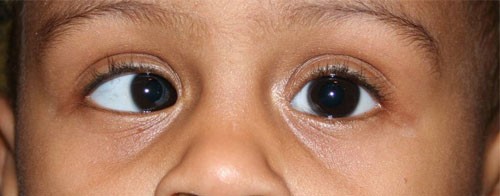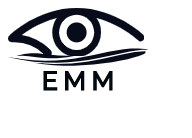Accommodative esotropia
Accommodative esotropia is the phenomenon of over convergence in response to neurologic stimulus that demands accommodation to see clearly at distance, intermediate and near point.
Linkage of accommodation and convergence
We can induce convergence without stimulating accommodation with the help of base out prisms; but we need to stimulate convergence before stimulating accommodation. The accommodation brings out accommodative convergence but convergence does not necessarily bring about accommodation. This linkage is the base of AC/A ratio.

Classification
High AC/A ratio accommodative esotropia
It occurs when the accommodation to see objects clearly induces very high convergence response than that which is actually required when optical correction is not being provided.
Hyperopic accommodative esotropia
It occurs when the link between accommodative stimulus and convergence stimulus is normal but the demand for accommodation is necessarily high than the normal opposite to ac/a type. However there may be patients who are facing both problems.
Accommodative esotropia based on hypo-accommodation
It is present in aphakic patients. They despite the absence of lens (an organ of accommodation) tend to accommodate.
AC/A ratio
People think that they measure ac/a ratio while measuring esotropia while using the gradient method to measure it. However, it is a useful tool to compare near and distance alignment as per accommodative demand.
There are people who put normal accommodation stimuli but respond to it in a very diminished way. For instance the cycloplegic patients try to accommodate even though they can’t. This phenomenon brings about additional accommodative stimulus which is not neurogenic. This induces over convergence. This induces both accommodative convergence and increased hyperopia for that moment.
Onset of accommodative esotropia
The typical age for the onset of accommodative esotropia is 2 to 3 years. 69 percent of children suffering from this manifest it at this age. However a small percentage may possess it above and below this age.
Management
According to Dr. Edward Raab, Professor of Ophthalmology and Pediatrics at Mount Sinai, New York, the management of newly found case of accommodative esotropia should include the complete elimination of extra accommodative effort.
- For this purpose, perform cycloplegic refraction with cycloplegic drugs (atropine and Cyclopentolate are common in use).
- It is seen that this eliminates extra accommodative effort and helps to successfully get rid of or lower the amount of esotropia.
- The goal is that the patient completely rely on the least treatment you provide.
- The goal is to expand their fusional divergence in their visual system.
Bifocals
Bifocals are very useful in the treatment of accommodative esotropia with high ac/a ratio. Bifocal; as the word indicates that these glasses are made for both distance and near vision. They are also useful for the treatment of esotropia. Sometimes the children can also have lazy manifested as eso- deviation even after using glasses for farsightedness. The bifocal glasses have correction for near work at the bottom. This relaxes accommodation and helpful to treat accommodative esotropia.
Complications
According to a study by Dr. Edward Raab more than half of the young patients of accommodative esotropia (up to 10 years of age) still present with some amount of it, however it is expected that typically their hyperopia would decrease. 29 percent will still present with esotropia after 12 years of age. There are patients with even small amount of accommodative esotropia persisting forever.
How to deal with this complication
Generally surgery is the option if the glasses fail to compensate the esotropia completely. The strabismus surgery is very helpful in this way. The strabismus surgery helps in reducing the crossing of eyes and aligning them to attain binocular vision.
The full amount of cycloplegic refraction should be given to the children for accommodative esotropia because the goal is to get rid of all the accommodative overconvergence.
Founder of EyesMatterMost- an optometry student who loves talking about eyes. I tend to cover topics related to optometry, ophthalmology, eye health, eyecare, eye cosmetics and everything in between. This website is a medium to educate my readers everything related to eyes.

